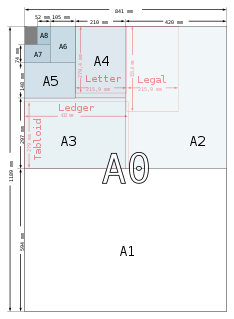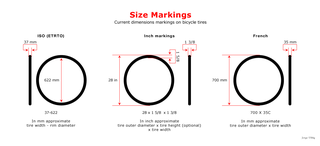ISO 8601Data elements and interchange formats – Information interchange – Representation of dates and times is an international standard covering the exchange of date- and time-related data. It was issued by the International Organization for Standardization (ISO) and was first published in 1988. The purpose of this standard is to provide an unambiguous and well-defined method of representing dates and times, so as to avoid misinterpretation of numeric representations of dates and times, particularly when data are transferred between countries with different conventions for writing numeric dates and times.
ISO/IEC 7816 is an international standard related to electronic identification cards with contacts, especially smart cards, managed jointly by the International Organization for Standardization (ISO) and the International Electrotechnical Commission (IEC).

Many paper size standards conventions have existed at different times and in different countries. Today, the A and B series of ISO 216, which includes the commonly used A4 size, are the international standard used by almost every country. However, in many countries in the Americas as well as in the Philippines, the North American series of paper sizes such as 'Letter' and 'Legal' is more prevalent.
An engineering drawing, a type of technical drawing, is used to fully and clearly define requirements for engineered items.

ISO/IEC 7810Identification cards — Physical characteristics is an international standard that defines the physical characteristics for identification cards.

Geometric dimensioning and tolerancing (GD&T) is a system for defining and communicating engineering tolerances. It uses a symbolic language on engineering drawings and computer-generated three-dimensional solid models that explicitly describe nominal geometry and its allowable variation. It tells the manufacturing staff and machines what degree of accuracy and precision is needed on each controlled feature of the part. GD&T is used to define the nominal geometry of parts and assemblies, to define the allowable variation in form and possible size of individual features, and to define the allowable variation between features.

ISO 5775 is an international standard for labeling the size of bicycle tires and rims. The system used was originally developed by the European Tyre and Rim Technical Organisation (ETRTO). It is designed to make tire sizing consistent and clear. It replaces overlapping informal systems that ambiguously distinguished between sizes. For example, at least 6 different "26 inch" sizes exist, and "27 inch" wheels have a larger diameter than American "28 inch" wheels. The Japanese standard JIS D 9421 specifies the same dimensional system, but adds details on additional rim types and also specifies additional parameters such as rim strength and details spoke holes.

An I-beam, also known as H-beam, w-beam, universal beam (UB), rolled steel joist (RSJ), or double-T, is a beam with an I or H-shaped cross-section. The horizontal elements of the "I" are known as flanges, while the vertical element is termed the "web". I-beams are usually made of structural steel and are used in construction and civil engineering.
CAD Standards are a set of guidelines for the way Computer-aided drafting (CAD), or (CADD) Computer Aided Design and Drawing, drawings should appear, to improve productivity and interchange of CAD documents between different offices and CAD programs, especially in architecture and engineering.
The ISO metric screw threads are the worldwide most commonly used type of general-purpose screw thread. They were one of the first international standards agreed when the International Organization for Standardization (ISO) was set up in 1947.

EXPRESS is a standard data modeling language for product data. EXPRESS is formalized in the ISO Standard for the Exchange of Product model STEP, and standardized as ISO 10303-11.
ISO/IEC 9995Information technology — Keyboard layouts for text and office systems is an ISO standard series defining layout principles for computer keyboards. It does not define specific layouts but provides the base for national and industry standards which define such layouts.
The ISO 217:2013 standard defines the RA and SRA paper formats.
A specification often refers to a set of documented requirements to be satisfied by a material, design, product, or service. A specification is often a type of technical standard.
ISO 732 is an ISO standard for medium format photographic film. The second (1982) edition of the standard specified the dimensions for 127, 120 and 620 roll film, backing paper and film spools. The third (1991) edition dropped specifications for the 127 and 620 roll films, which had become largely obsolete in the photography industry and added specifications for 220 roll film. The current (2000) edition incorporates the now withdrawn standard ISO 1048 on identification of exposed roll films.
ISO 128 is an international standard (ISO), about the general principles of presentation in technical drawings, specifically the graphical representation of objects on technical drawings.
ISO 8501-1 – Preparation of steel substrates before application of paints and related products – Visual assessment of surface cleanliness – Part 1: Rust grades and preparation grades of uncoated steel substrates and of steel substrates after overall removal of previous coatings
ISO 965 is an International Organization for Standardization (ISO) standard for metric screw thread tolerances. It specifies the basic profile for ISO general purpose metric screw threads (M) conforming to ISO 261.
ISO 668 - Series 1 freight containers — Classification, dimensions and ratings is an ISO international standard which classifies intermodal freight shipping containers and standardises their size and weight specifications. Introduced in 1968, ISO 668 regulates both external and internal dimensions of containers, as well as the minimum door opening size, where applicable. It also specifies the associated gross weight ratings, and requirements for load transfer areas in the base structures of containers, since amendment 1 of 2005.
DIN 1025 is a DIN standard which defines the dimensions, masses and sectional properties of hot rolled I-beams.






